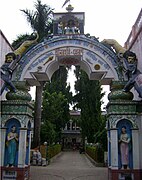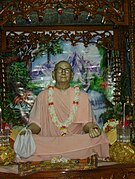
Abhay Charanaravinda Bhaktivedanta Swami was an Indian Gaudiya Vaishnava guru who founded ISKCON, commonly known as the "Hare Krishna movement". Members of ISKCON view Bhaktivedanta Swami as a representative and messenger of Chaitanya Mahaprabhu.

Chaitanya Mahaprabhu was a 15th century Indian Saint, who is considered to be the combined avatar of Radha and Krishna by his disciples and various scriptures. Chaitanya Mahaprabhu's mode of worshipping Krishna with ecstatic song and dance had a profound effect on Vaishnavism in Bengal. He was also the chief proponent of the Vedantic philosophy of Achintya Bheda Abheda Tattva. Mahaprabhu founded Gaudiya Vaishnavism. He expounded Bhakti yoga and popularized the chanting of the Hare Krishna Maha-mantra. He composed the Shikshashtakam.
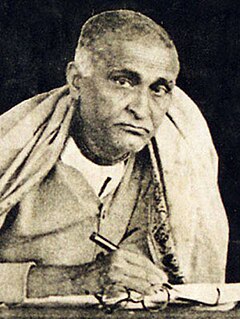
Bhaktisiddhanta Sarasvati, born Bimala Prasad Datt, was a Gaudīya Vaisnava Hindu guru, ācārya, and revivalist in early 20th century India. To his followers, he was known as Srila Prabhupāda.

Gaudiya Vaishnavism, also known as Bengali Vaishnavism, Chaitanya Vaishnavism, the Bengali/Chaitanya/Gaudiya Sampradaya, Chaitanyaism and Gaura Dharma, is a Vaishnava Hindu religious movement inspired by Chaitanya Mahaprabhu (1486–1534) in India. "Gaudiya" refers to the Gaura or Gauḍa region of Bengal, with Vaishnavism meaning "the worship of Vishnu". Specifically, it is part of Krishnaism—Krishna-centric Vaishnavite traditions. Its theological basis is primarily that of the Bhagavad Gita and Bhagavata Purana, as interpreted by early followers of Chaitanya, such as Sanatana Goswami, Rupa Goswami, Jiva Goswami, Gopala Bhatta Goswami and others.

Narottama Dasa Thakura, also known as Thakura Mahasaya, was a Gaudiya Vaishnava saint who was responsible for spreading Vaishnava bhakti throughout Odisha in and outside of Bengal in India. Narottama Dasa was the son of King Krishnananda Datta and Narayani Devi who resided in Gopalpur Pargana of the Rajshahi district of Bangladesh. According to some, after the death of his father he entrusted his royal duties to the eldest paternal uncle's son and left for Vrindavana.

The Gaudiya Math is a Gaudiya Vaishnava matha formed on 6 September 1920, about 30 months after Bhaktisiddhanta Sarasvati took sannyasa, the renounced order of life. On 7 March 1918, the same day he took sannyasa, he established the Sri Chaitanya Math in Mayapura in West Bengal, later recognised as the parent body of all the Gaudiya Math branches. Its purpose was to spread Gaudiya Vaishnavism, the philosophy of the medieval Vaisnava saint Chaitanya Mahaprabhu, through preaching and publishing.

Jiva Goswami was an Indian philosopher and saint from the Gaudiya Vaishnava school of Vedanta tradition, producing a great number of philosophical works on the theology and practice of Bhakti yoga, Vaishnava Vedanta and associated disciplines. He is known as one of the Six Goswamis of Vrindavan and was the nephew of the two leading figures, Rupa Goswami and Sanatana Goswami.

Bhaktisvarupa Damodara Swami, also known as Dr. Thoudam Damodara Singh and by the honorific Sripada, was a Gaudiya Vaishnava spiritual leader, scientist, writer and poet. In 1971 he received spiritual initiation from A. C. Bhaktivedanta Swami Prabhupada. A few years later he became one of the religious leaders of the International Society for Krishna Consciousness.

Bhakti Hridaya Bon, also known as Swami Bon, was a disciple of Bhaktisiddhanta Sarasvati and a guru in the Gaudiya Math following the philosophy of the Bhakti marg, specifically of Caitanya Mahaprabhu and Gaudiya Vaishnava theology. At the time of his death, he left behind thousands of Bengali disciples in India.

The Brahma Samhita is a Sanskrit Pancharatra text, composed of verses of prayer spoken by Brahma glorifying the Lord Krishna, or Govinda, at the beginning of creation.
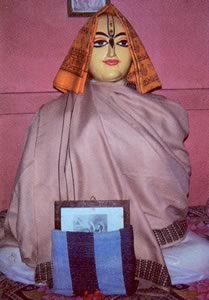
Haridasa Thakur was a prominent Vaishnava saint known for being instrumental in the initial propagation of the Hare Krishna movement. He is considered to be the most famous convert of Chaitanya Mahaprabhu, apart from Rupa Goswami and Sanatana Goswami. His story of integrity and unflinching faith in the face of extreme adversity is told in Chaitanya Charitamrita, Antya lila. It is believed that Chaitanya Mahaprabhu himself designated Haridasa as nāmācarya, meaning the 'teacher of the Name'. Haridasa Thakura, was a devotee of God, Krishna, and had practiced chanting the names of the Lord, Hare Krishna, 300,000 times daily.
Prabhupāda is an honorific used by the International Society for Krishna Consciousness (ISKCON), and some other Gaudiya Vaishnava groups, to refer to ISKCON founder A. C. Bhaktivedanta Swami.

Bhakti Prajnan Keshava, addressed by the honorific Mahārāja, was a Gaudiya Vaishnava guru, disciple of Bhaktisiddhanta Sarasvati and the founder-acharya of the religious organisation "Sri Gaudiya Vedanta Samiti", formed in Calcutta in 1940, and its geadquarters, monastery Sri Devananda Gaudiya Math in Nabadwip.
Brihad-bhagavatamrita is a sacred text for followers of Hindu tradition of Gaudiya Vaishnavism. Along with Hari-bhakti-vilasa, it is one of the most important works of Vaishnava theologian Sanatana Goswami. While Hari-Bhakti-Vilasa sets out guidance for Vaishnava behavior and ritual, Brihad-bhagavatamrita contains an analysis of the teachings of Chaitanya from an ontological and metaphysical perspective.

Tripurari Swami, also known as Swami Tripurari and Swami BV Tripurari, is an American author, poet, and guru, described as "a prominent master in the Gaudiya Vaishnava lineage", and "one of the leading practitioners of Bhakti-yoga in the West".

An ISKCON guru is a person who is permitted to initiate disciples into the International Society for Krishna Consciousness system. The guru system has undergone several changes and reform since its beginnings in the 1960s. Upanayana as a traditional "sacred thread ceremony" of the Gayatri Mantra, commonly known Hindu Samskara, is complemented by Pancaratric mantras of the Gaudiya Vaishnava sampradaya and follows the principal initial nama initiation ceremony, referred to respectively as brahmana diksa and Hari nama diksa.
This is a list of works by Bhaktisiddhanta Sarasvati (1874-1937), a Gaudiya Vaishnava leader and religious reformer. This list includes his original works, commentaries on canonical Vaishnava texts, and articles in periodicals Sajjana-toshani and the Gaudiya.

The Gaudiya Mission is a Gaudiya Vaishnava monastic and missionary organization whose founder acharya is Srila Prabhupad alias Srimad Bhakti Siddhanta Sarasvati Goswami Maharaja. The organisation has been registered since March 1940 in Calcutta, British India under the supervision of the then Acharya Srila Acharyadev alias Srimad Bhakti Prasad Puri Goswami Maharaj after accepting sannyasa in 1939/1941.
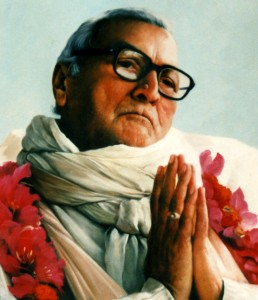
Bhakti Rakshak Sridhar was an Indian guru, writer, sannyasi and spiritual leader in the Gaudiya Vaishnava tradition of Chaitanya Mahaprabhu, founder-president-acharya of the Sri Chaitanya Saraswat Math.




